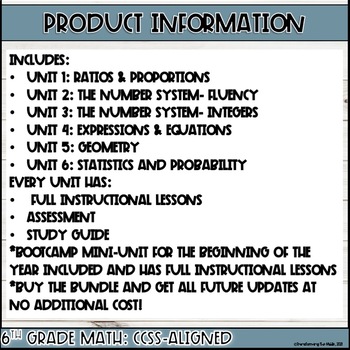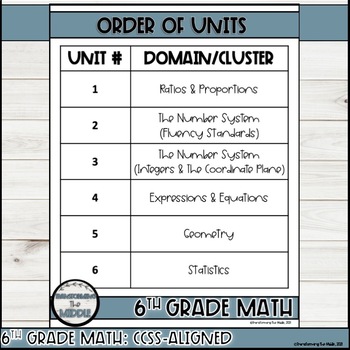6th Grade Math Curriculum CCSS Aligned Bundle
- Zip

What educators are saying
Products in this Bundle (8)
showing 1-5 of 8 products
Bonus
Description
This 6th grade Math CCSS aligned curriculum is a full year bundle that contains 6 units for teaching all 6th grade standards. The growing bundle has 6 units: Ratios and Proportions, The Number System Fluency, The Number System Integers & The Coordinate Plane, Expressions & Equations, Geometry, and Statistics and a beginning of the year bootcamp mini unit. Every unit covers all standards under each 6th grade domain.
About This Product and What's Included:
-This Bundle will give you free access to future updates, which means once you purchase, you will get all updates and additions at NO extra cost.
- ALL instructional lessons have been added to this bundle.
- Unit 0: Bootcamp Lessons
- Unit 1: Ratios and Proportions
- Unit 2: The Number System- Fluency
- Unit 3: The Number System- Integers and the Coordinate Plane
- Unit 4: Expressions and Equations
- Unit 5: Geometry
- Unit 6: Statistics & Probability
-Each unit is a zip file with individual folders with all materials
- Full instructional lessons
- Study Guide
- Assessment
-Each lesson includes:
- 1 teacher tips page that explains key points and ideas to focus on
- 5 student lesson pages
- 1 "Big Ideas" page (direct instruction or exploration)
- 1 "Guided Notes" page (gradual release or guided instruction)
- 2 "Practice" pages (differentiated for independent practice)
- 1 "Exit Ticket" (check for student understanding)
-Also included in each unit is a unit map to help you plan and pace out your lessons.
- There are 56 lessons in this bundle
- You can find each lesson individually in our store
-Aligned to 6th grade Common Core Standards
-Non-editable
-Notebook divider tabs included to organize student notebooks
-Please note that this bundle, just like any curriculum, may need supplemental resources to best meet the needs of your students. As aligned and targeted as this set of units is to 6th grade students and standards, we know there is not a one size fits all answer so please keep that in mind.
**If you purchase this bundle, please be sure to download the "Bonus File" to get the Starter Guide that has cover pages, tips, and more!
What are the benefits of using Transforming the Middle's Curriculum?
Natalie and Katy are two 6th grade Math teachers in the classroom presently. Together, they have over 17 years of experience teaching grades K-8. The lesson(s) in Transforming the Middle are what they built for their students and have used for over 5 years now. The lessons in this curriculum have impacted their students' academic growth, engagement, and mindset in Math year after year. They have built these strong foundational lessons for you to take into your own classroom and use with your own teaching style so that your students can also find their love for Math.
Individual 6th Grade Units:
Unit 1: Ratios and Proportions
Unit 2: The Number System-Fluency
Unit 3: The Number System- Integers and the Coordinate Plane
Unit 4: Expressions and Equations
Unit 6: Statistics and Probability
How to get TPT credit to use on future purchases:
Go to your "My Purchases" page (make sure you are logged in).
Next to each purchase you'll see a "Provide Feedback" button.
Click it and you will be navigated to a page where you can give a rating and leave a comment for that product.
Each time you complete a feedback, TPT will give you feedback credits that you can put towards saving money on future purchases.





